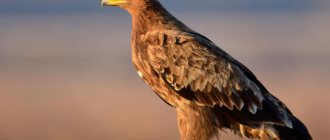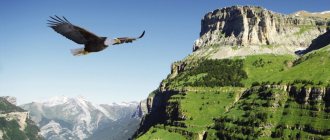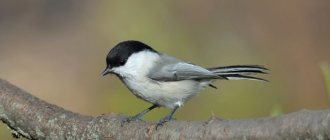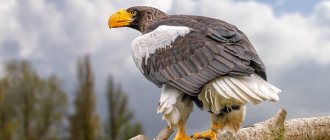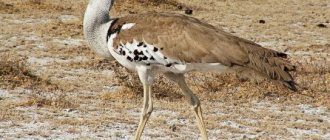- August 22, 2019
- Miscellaneous
- Olga Safonova
The eagle is the personification of wisdom, courage and strength. This beautiful bird of prey with many virtues is called the king of the sky. For all nations, the eagle is a symbol of insight and courage. His flight is mesmerizing. Seeing this royal bird soaring in the sky is considered a good sign. They fear him, they admire him. However, there are also those who hunt eagles. Who is this?
Interesting facts about the steppe eagle. Steppe Eagle – interesting facts
The steppe eagle is a unique bird that is listed in the red books of many countries.
For example, in Kazakhstan, the population of steppe eagles is gradually declining, and both poaching and the death of eagles on power lines are to blame. What interesting facts about eagles are known today? What makes this bird unique? Why do scientists around the world continue to study it closely? Let's consider only three such features: vision, piloting, caring for chicks. Vision
The vision of all species of eagles, including steppe eagles, is amazingly sharp. The Guinness Book of Records says that an eagle can see prey at a distance of two kilometers. But some experts argue that eagles can see even further.
Such vision is possible due to the special structure of the eye. An eagle has five times more light-sensitive cells than a human. Thus, an eagle has 1,000,000 cones per square millimeter, while humans have only 200,000. Each of these cells is connected to a neuron that transmits information to the brain. It's no surprise that eagles are excellent at distinguishing colors. But that's not all the amazing features of the eyes.
The eagle's lens is capable of very quickly changing focal length, instantly moving the gaze from objects near to objects in the distance. During the hunt, his vision constantly changes the sharpness of focus, adapting to the movement of the prey. Scientists are studying this unique feature of the eagle's eyes to create and improve models.
Piloting
The weight of an eagle can reach almost five kilograms, but this does not prevent it from soaring calmly in the air, causing the delight of observers. What is the secret of its amazing ability to fly at altitude with minimal effort.
Interesting facts about the flights of eagles enable aircraft designers to create more economical and practical airliners. The eagle knows how to catch rising currents of warm air. And although these streams cannot be seen with the eye, this huge bird is a master at finding them. Then, spreading its tail and wings, the eagle circles within its boundaries, which gradually lifts our hero higher and higher. Having reached a certain height, the eagle smoothly moves into another stream of warm air and continues to soar for hours, expending a minimum of energy.
Scientists have found that the eagle has such capabilities, thanks not only to its wide wings, but also to special feathers at the ends of the wing. These feathers bend almost vertically during flight. This wing design allows for maximum lift with minimal energy consumption.
Engineers around the world are studying eagles and other birds to improve the performance of modern aircraft. For example, the use of wings equipped with winglets, or tip wings as they are also called, improves the flight performance of aircraft by approximately 15%. Winglets are actively used by many airlines. Thus, over the past 10 years, thanks to the end wings, more than 7.5 billion liters of fuel have been saved.
But the eagle is not only a virtuoso of flight. These birds have another advantage.
Caring for the chicks
Steppe eagles and other species of eagles are excellent parents. Instinctively, they understand that the most dangerous age in an eaglet's life begins when they begin to learn to fly. A lot of babies die at this time. What do caring mothers do?
On hot days, they hover over the chicks, protecting them from the hot rays of the sun, like under an umbrella. During strong cold winds, the wings become a reliable shelter and prevent babies from freezing. And when baby eaglets begin to fly, with the help of their huge wings they sometimes not only support the babies, but can even support them in flight.
Here are just some interesting facts about the amazing abilities of the eagle, this graceful bird that helps improve our modern lives.
Features of reproduction
The breeding of eagles is closely related to the availability of food in the region. If they see that there is not enough prey to feed their offspring, they stop building nests and switch to a nomadic lifestyle, where all efforts are aimed at finding food. When there is enough food, predators begin to look for a partner in April - May. The nesting characteristics of these representatives of the class of birds depend on the habitat.
Mating and reproduction
Among the interesting information about the steppe eagle, it can be noted that these birds form a pair for life - this is typical for almost all accipitridines. Both parents have clearly divided responsibilities. The mating season begins immediately upon the arrival of predators from wintering grounds, when the last snow melts. In the south this happens in mid-late March, in the northern zones - closer to the beginning of April.
The mating rituals of eagles consist of joint figure flights, games in the air, and displays of plumage. You can often hear the voices of these birds when they are trying to attract a partner or drive away a competitor.
After mating, the female lays 2-3 eggs. They are small, white with chaotic yellowish and brownish spots. The eagle incubates and protects the clutch, from which, after 1.5 months, grayish-white, helpless chicks covered with down appear. Their first plumage appears after 1-1.5 months, and full development ends after 4 years. The lifespan of an eagle in captivity is up to 48-50 years, but in natural conditions most individuals die much earlier.
Eagle nesting
Eagles are unpretentious when choosing a place for a nest. They make their home at the bases and ledges of rocks, among bushes, in the crowns of lonely trees, on earthen or sandy hills. If a predator lives near a populated area, it may choose a pile of garbage or scrap metal, a haystack, a destroyed building, or a power line support. The main conditions are good visibility of the surrounding area and the ability to freely fly up to the shelter from above.
Birds' nests are massive, up to 0.7−1 m in diameter. They try not to place it too high - the dwelling is built either on the ground or at a height of 1-2 meters. The materials used are branches, plant stems, dry grass, and bunches. Often, a predator brings there scraps of skins, bones, manure, pieces of paper and cardboard, wire and various small objects created by man.
If the nest is placed on the surface, then it consists of a litter of chaotically scattered branches and patches of grass. On trees and hills, structures appear more solid. As a rule, they are quite strong and can withstand bad weather and wind. The eagle renews its home every year, returning from another winter flight to warm countries.
Caring for offspring
Newly hatched eaglets are born helpless and vulnerable . Both parents are actively involved in the life of the chicks, ensuring their survival until maturity. The male obtains food by bringing the female and her cubs carcasses of gophers and other rodents. The mother of the family warms and hatches the children. The eagle and she-eagle actively protect the brood from any danger. This applies not only to the threat of attack by predators - for example, during hot weather, birds open their wings wide, creating shade for their offspring.
Steppe eagle chicks appear at some interval and are often of different ages. Competition for food arises between them, which is why the smallest and weakest younger individuals often die of hunger. In the first weeks of life, the female tears food for them, since the cubs themselves cannot do this. As soon as they grow up and learn to peck prey on their own, the mother joins the father in the hunt and together they feed the brood.
At the age of 60 days, the chicks learn to fly independently. By August, they leave the mother’s nest and begin to hunt on their own, but can remain within the nesting area for a long time. The size of the parents' territory depends on the characteristics of the site and the amount of food on it. In areas untouched by humans and rich in vegetation, where large populations of rodents are found, nests can be very close - 1 km from each other.
Eagle information. Description
Eagles are birds of prey belonging to the Accipitridae family. They have an impressive physique, wide, impressively sized wings. Other distinctive features of these birds:
strong, sharp beak, curved at the end;
- massive neck;
- small head;
- sedentary eyes;
- muscular, feathered limbs;
- long, rounded, sharp claws on the paws.
During life, both the talons and beak of an eagle have the inherent property of growing. But this ability is compensated by their gradual grinding down.
Eagles are able to rise to significant heights, up to 700 m. Acute vision helps them track down prey. These birds of prey do not understand odors well. Hearing is used exclusively for communication with each other.
Males are usually smaller than females. Almost all species of eagles are large in size. The weight of an adult can reach up to 6 kg. The body length ranges from 0.8 to 0.95 m. The exception is the steppe eagle and the dwarf eagle.
The wingspan of an eagle can reach 2.5 m. This makes it possible to soar above the ground for a long time.
The tail section is shortened. As can be seen in the photo of eagles, in some species the tail has a wedge-shaped shape, reminiscent of a fan. The crested and African crested subspecies are distinguished by a crown of long feathers on the head.
The color of the plumage depends on the subspecies. The color can be maintained in one tone with streaks, or in several contrasting ones.
The flight of the eagle, a bird of prey, is a fascinating sight. It is distinguished by maneuverability and powerful flapping of its wings. This amazing creature is not afraid of winds. Having seen the victim, it is capable of diving down, reaching speeds of up to 320 km/h.
Eagles live approximately 30 years. Some species can live up to 50 years.
Can a steppe eagle eat a fox? After a successful hunt in the snow, the fox was attacked by an eagle
If you thought that predators easily get their food, then you can look at the fox, which, although it likes this activity, it does not always happen that it goes without complications.
The common fox is well known to all of us.
Fox is the common name for several species of mammals of the canine family. The most famous and widespread representative is the common fox (Vulpes vulpes) - a predatory mammal of the canine family, the most common and largest species of the genus of foxes. Body length is from 60 to 90 cm, tail from 40 to 60 cm and weight from 6 to 10 kg.
You can't deny a fox a hunter's instincts and skills. Using her unique sense of smell, she can detect her favorite treat - rodents, even under a thick layer of snow.
There are living creatures out there somewhere, for sure.
For the winter period, when voles become the main diet for the fox, you cannot neglect your skills. Each mouse discovered must fall into the mouth of the “red beast”.
Fox hunting is very funny. This is a must see! Having smelled prey under the snow cover, the fox tries to hear any sound, squeak or rustle. But this is not the most interesting thing, but the fact that for her lunch she dives straight into the snow.
The back sometimes gets in the way and outweighs.
Gathering all her being for the final chord of the hunt, she purposefully looks at one point, gathers her thoughts about food and jumps.
“Where are you going?” I want to ask.
But having soared into the air for a moment, the fox immediately breaks through the crust of snow with its nose and tries in every possible way to grab and catch the mouse.
And what can you see on such a canvas of white snow?
Not to say that luck always smiles on our hunter, there are also mistakes, and sometimes the victim is not particularly eager to get on someone’s table. But with age and experience, honed by many attempts, fate smiles more often on the fox than on the mouse.
Such winter gastronomic fun as hunting for a rodent in the snow even received its own name - “mousing”.
This time the hunt will be successful.
She's not the only one, she's so smart!
Satisfied and joyful with the results of her painstaking work and skill, the fox would now enjoy the caught trophy and somewhere afterward take a nap and relax. But nature also made sure that other predators could encroach on predators. Who said it would be easy?
The fox caught his own mouse, and someone else can catch the fox himself.
Here we are no longer talking about a full stomach, but about life, which can be lost in the tenacious paws of an eagle. It costs him nothing not only to take the prey from the fox, but also to turn it into a lifeless body.
Flies and attacks. I even feel sorry for the poor fox.
All that remains for the fox to do is to run and hope for a miracle, which she will of course be happy to help, trying to confuse the “air attack” and sharply changing the direction of her run, turning around and defending herself. But will it help?
Are you a victim or a game, and when did everything change?
It is easier to catch up with a running target from the air than to look for food under the snow. And the one who found a piece of meat for herself and even managed to eat a little of it, becomes a victim herself. This is the cycle of life in nature.
The fox escaped from the eagle, but she’s hungry again!
There’s nothing to be done, the law is harsh - “Either you or you!”
LAW OF NATURE: “EITHER YOU OR YOU!”
If the story turned out to be useful, then it’s time to confirm it with a like and subscription. And be sure to share your thoughts and observations in the comments.
Eagle molt. Eagle king or martyr
Even in ancient times, this bird symbolized unlimited power, this was facilitated by a special temperament and unshakable pride. The flight of an eagle is mesmerizing.
But not everything is so simple, few people know that after forty years the eagle turns into a helpless baby, this happens because with reptiles the eagle gradually grows to such a size that the bird is simply unable to provide food for itself, the victim literally escapes from the “unkempt” eagle claws
The situation is no better with the beak. Over time, the eagle's beak becomes so bent that the bird cannot eat. And the appearance of the eagle is not pleasing. Feathers fall out, bald patches appear on the wings of the chest, all this makes weeding more difficult.
This is where the tough nature of the predator comes into play; he must choose to live or die. If a bird chooses life. He needs to undergo a difficult and, most importantly, painful procedure that will last for 150 days.
To survive, the bird climbs to the top of the mountain where the nest is located. Here the eagle brutally hits the stones with its beak. This is done in order to completely split the beak. Some time will pass before the eagle has a new beak, now it can get rid of unnecessary claws, it literally rips them out of the body. The final touch remains: with the help of its beak and claws, the eagle pulls out old feathers.
One can only envy such strength of character; after 5 months of hellish pain, the eagle will be reborn like a phoenix and will live for many more years.
How does an eagle fly?
Without any visible effort, but with great power, the eagle will flap its wings once or twice, and then the hand of the air flow, invisible to the eye, picks it up and lifts it up. The huge bird flies higher and higher, only occasionally moving its wings.
Interesting materials:
Is it possible to erect monuments on the graves of Orthodox Christians? Is it possible to put roses in the refrigerator? Is it possible to place vacuum cups on the spine? Is it possible to wash without spinning? Can Reim's boots be washed? Can Reima overalls be washed? Can socks be washed with clothes? Is it possible to stand in a plank for more than a minute? Is it possible to cut your hair on Dormition? Is it possible to dry hawthorn in the sun?
Crimean eagle. Nest of the Crimean Imperial Eagle. 2019
One of the most realistic places to shoot and at the same time controversial topics in animal photography is photographing birds on their nests. Many photographers are ready to climb headlong into the nest just to get the desired shot. Over time, the understanding comes that 99% of the shots obtained in such conditions were not worth the risk to which the birds were exposed. We extremely rarely, and only after assessing all the risks, can we film on nests. And only if it is possible to get the frame we need. Or, as in this case, capture a very interesting fact.
As a rule, large eagles have no more than 2 chicks. 3 chicks are extremely rare. At least in Crimea, this is the second such meeting when as many as 3 birds grew up in the nest of the imperial eagle. This nest has been known for a long time, and our friend Crimean ornithologist Sergei Prokopenko monitors it every year. For us, as animal photographers, this nest was not particularly interesting, since filming would have done more harm to the birds than good. But we couldn’t miss the opportunity to film such an event. While we were planning from afar where best to place the camera trap, the chicks stood on the nest and three eaglets could be clearly distinguished. But when we got closer, they lay down and it was impossible to get a more or less acceptable shot. In general, while Sergei was installing a camera trap on a nearby tree, we took some pictures of the young eagles from below. The camera trap did the rest for us. Unfortunately, the tree on which this nest is located has completely dried out this year, although last year it was hidden from view by an abundance of greenery. So, despite this nest being more than 10 years old, there is a danger that it may fall. But Sergei had already planned to place a camera trap on a nearby tree, where the eagles could make a new nest, if necessary.
Natural enemies of eagles in nature
Eagles are predators, serious predators. Even bears have a hard time resisting them. With a blow from their paw they are able to break the spine of even a large animal. And if the species of eagles is quite large, natural enemies simply do not exist in nature.
The great advantage of these magnificent birds is the ability to attack from the air, incredible strength and rapid speed. As a rule, if they go on the attack, the fight ends in their favor.
But eggs laid in nests and chicks turn out to be tempting targets. If someone asks who hunts eagles from animals, the answer may seem funny. Most often these are small animals, smaller than a squirrel. And of course, foxes.
Those who love to eat are the animals that live in the area where the eagle lives. Wherever an eagle makes a nest, be it in the desert or high on a cliff, there are plenty of people who want to visit. What can we say about individuals whose habitats are steppes, semi-steppe zones, forests and coasts?
Some species of eagles compete for food with hawks, crows, ospreys, and gulls, but they do not pose a direct threat to the formidable predator. It happens that crows pursue some species of eagles, but this cannot in any way be called predatory behavior towards the king of the sky.
In general, the level of threat against eagles depends on the size and age of the individual. The most vulnerable are the chicks. Adult birds are scary, and they have practically no enemies. After all, eagles are considered the most powerful birds. So there are simply no people who hunt eagles.
Steppe eagle of the Krasnodar region. Steppe Eagle of the Rostov region
Class Birds – Aves Order Falconiformes Family Accipitridae – Accipitridae Aquila nipalensis Hodgson, 1833 Rarity status category. 13). In the Rostov region. a very rare, endangered nesting species, entering from the east at the edge of its range, a rare species in Russia.
Description
A very large bird of prey of a uniform dark brown color, with wide blunt wings up to 2 m in span and a wide rounded tail. Eagles soar easily, circling over the steppe for a long time and tracking gophers from above. Often they also sit on poles along the roads, guarding unwary animals here.
Spreading
South-East. Europe, Kazakhstan, Mongolia, Center. Asia. In Russia, in the past it was widespread throughout the steppe zone east to Transbaikalia, but as the steppes were developed and plowed, the range decreased, and now the steppe eagle nests almost nowhere to the west of Ergeni. In the Rostov region. back at the end of the 19th century. he lived in the Azov steppes and along the river. Derkul, and in the first half of the 20th century. was a characteristic species of the dry Salsk and Don steppes, located east of the Seversky Donets, penetrating north to the Chertkovsky, Tarasovsky, Kasharsky and Morozovsky districts. In the middle of the twentieth century. the birds still nested in Zamanychye, on the right bank of the Lower Don they reached the Konstantinovsky, Milyutinsky and Sovetsky districts and probably lived in the Sholokhovsky district. Nowadays they are preserved in small numbers only in the extreme southeast of the Rostov region. in the Zavetinsky district, but individual pairs may still be found along extensive ravines in the northeastern districts, penetrating there from the Kalach bend of the Don.
Range and habitat
The steppe eagle is a migratory bird that flies to warm climates for the winter. Its main habitats, where it nests and lives for most of the year, include the following areas:
- western part of China;
- territories of Central and Central Asia;
- Kazakhstan;
- Mongolia;
- southeast Pakistan, especially Karachi;
- Orenburg, Astrakhan, Volgograd and Rostov regions of Russia, Kalmykia, Stavropol Territory, southern zones of the Urals, southwest and southeast of Siberia.
For the winter, birds migrate to southern, central and eastern Africa, India, and the Arabian Peninsula. Predators begin traveling to warm countries at the end of September or beginning of October and return by April. The flight is most often made alone, sometimes in small groups of 2-3. On the way, they make stops, during which they feed and rest - then up to 5 individuals can flock together.
During the migration period, eagles can often be seen outside their usual range, for example, in Nepal. History knows of cases when 15-16 birds flew there in 1 hour.
As a place to live, the predator chooses plains with a lot of free open space. He prefers to settle in places with low vegetation and untouched land - it is easier to look out for prey and hunt there. The attractiveness of an area to eagles is strongly determined by the amount of prey available.
The bird of prey feels equally at home in steppes, deserts and semi-deserts, and grassy plains. It can also live in hilly areas, near cliffs or mountain peaks high above sea level, but there must be open hunting ground nearby. The eagle also settles near cities and villages, where the availability of food and shelter attracts a large number of rodents and small birds. Sometimes it can be seen near populated areas during migration.
Plan of communication about the steppe eagle. Steppe eagle - predatory and faithful
More than 780 species of birds live in Russia. Many are listed in the Red Book. One of the largest feathered predators is the steppe eagle. Its habitat is mainly steppes: in Russia these are the regions of the Lower Volga region, the south of Central and Western Siberia, and the Caspian lowland.
Peculiarities
The predator is dark brown in color and has a short, rounded tail. On the back of the bird's head there is a small rusty stain. Its size may vary depending on the species of individual. A young bird has a narrow white stripe on the underside of its wing, which persists during the first years of life. It is thanks to this stripe that you can easily distinguish the steppe eagle from other species.
- Body length - 85 centimeters.
- The wingspan is about 3 meters.
- The weight of the bird is from 2 to 5.5 kilograms.
- Females are much larger than males.
- Life expectancy is 40-50 years.
The steppe predator prefers open spaces. Nests are usually made on the ground. The bird has weak fingers and short claws, which is why it can only attack relatively small animals. The eagle feeds mainly on voles, gophers, hamsters, and hares. It flies to Transcaucasia, India or Africa for the winter.
Reproduction
Steppe eagles live in sedentary pairs. Sometimes birds nest on power lines. This often causes death. The steppe eagle easily captures the nests of crows or falcons and builds them to the required size. The bird breeds only once a year. There are up to 3 eggs in a clutch. Incubation can last from 35 to 45 days.
Caring for future offspring falls entirely on the female. At this time, the father of the family supplies her with food. The mother continues to warm the hatched chicks with her warmth only for some time, and then also begins to leave in search of prey. Parents always show touching care for their offspring. Chicks show an aggressive character from birth. They often quarrel over food. The strong ones even peck at the weaker chicks and then eat them.
As soon as the hatched offspring rises to the wing, they begin to hunt on their own, but for some time they continue to use the feeding of their parents. Birds reach sexual maturity at the age of 4 years. They lead a nomadic lifestyle until they find a mate. They remain faithful to their partner until the end of their lives.
Threat of extinction
Despite their strength, steppe eagles are a vulnerable link in the ecological chain. In their reports, scientists often mention that for the normal existence of this bird, an area untouched by human activity is required. Due to the fact that steppe spaces are increasingly being converted into arable land, the population of the steppe eagle has sharply decreased. Chemicals and rodent extermination have a harmful effect on the bird's body. If urgent measures are not taken, then very soon this species of feathered predator may disappear completely.
Hunting and diet
Any child knows that an eagle is a predator. The basis of its diet is large rodents, including:
- gophers;
- hares;
- lemmings;
- marmots; gerbils.
Sometimes small birds, chicks, reptiles, and unattended eggs become food for birds. An interesting fact about the steppe eagle - despite its reputation as a noble and skillful hunter, it will not disdain the carcass of an animal that died a natural death or the leftovers from another animal’s dinner.
The predator hunts during daylight hours. In this he is helped by the famous “eagle vision” and a wide viewing angle, which helps him notice rodents from great heights and distances. Having noticed potential prey, the bird sharply lowers its height, falling almost like a stone, and grabs the victim with sharp hooked claws. Having finished off the victim, he retires to a secluded nest, where he eats.
There are eyewitness accounts of eagles attacking from ambush. This happens if a hunter manages to track down a large colony of gophers or other rodents. The bird swoops over the hole for hours, waiting for the right moment to attack, or takes a position on the ground, hiding behind a stone or hill. When the prey comes to light, the predator takes off and overtakes it in seconds. Strong legs and the ability to run very quickly (although not for long) on the ground provide him with excellent adaptability to this type of hunting.
Among what the steppe eagle feeds on in the steppe, carrion is not the least important. It is especially important during periods of declining rodent populations. Sometimes up to 10 individuals gather over one carcass, eating prey without any clashes or conflicts during the feeding process.
